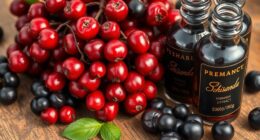For individuals struggling with neuropathic pain, certain herbs have shown significant promise in alleviating discomfort and inflammation associated with nerve damage. St. John's Wort, known for its antidepressant properties, and turmeric, containing anti-inflammatory curcumin, are effective in reducing pain. Passionflower, a natural sedative, and ginger, with its anti-inflammatory properties, also provide relief. Valerian root, a natural muscle relaxant, can help with pain management. To maximize the benefits of these herbs, it's essential to understand how to incorporate them effectively, considering individual needs, health status, and medication interactions, and by doing so, individuals can find much-needed relief from nerve pain. Further guidance on strategic herbal integration can lead to even greater success.
Key Takeaways
• St. John's Wort is known for its antidepressant properties, which can help alleviate nerve pain symptoms.
• Turmeric contains curcumin, which has potent anti-inflammatory properties that can reduce nerve pain and inflammation.
• Passionflower is a natural sedative that can help reduce anxiety and promote relaxation, providing relief from nerve pain.
• Ginger has anti-inflammatory properties that can help reduce pain and inflammation associated with nerve pain.
• Valerian root is a natural muscle relaxant that can help relieve nerve pain by reducing muscle tension and promoting relaxation.
Understanding Nerve Pain Basics
Nerve pain, also known as neuropathy, occurs when damaged nerves disrupt the normal transmission of signals between the brain and the rest of the body. This disruption can lead to a range of uncomfortable and painful symptoms.
Damaged nerves can be caused by various factors, including diabetes, injuries, infections, autoimmune diseases, and chemotherapy. Understanding the diverse causes of nerve pain is essential for effective management and treatment.
Recognizing Nerve Pain Symptoms

Symptoms of nerve damage can manifest in a variety of ways, often starting with subtle sensations that can escalate into debilitating pain if left untreated. Recognizing these symptoms is essential for effective management of nerve pain.
- Tingling or numbness in hands and feet
- Sharp, stabbing, or burning pain
- Muscle weakness or lack of coordination
- Hyperalgesia or increased sensitivity to pain
- Abnormal sensations, such as feeling of wearing gloves or socks when none are present
Managing Nerve Pain Strategies

By combining medicinal therapies with lifestyle modifications and alternative treatments, individuals can develop a holistic approach to managing nerve pain.
Medicinal therapies, such as anticonvulsants and antidepressants, can alleviate nerve pain.
Lifestyle modifications, including balanced blood sugar levels and regular exercise, can also help.
Alternative treatments like acupuncture and massage therapy have shown positive results in reducing nerve pain.
Early diagnosis is essential for effective management of nerve pain.
A thorough treatment plan should include a combination of these strategies to provide maximum relief.
Natural Herbs for Nerve Relief

Incorporating natural herbs into a holistic treatment plan can provide significant relief from nerve pain, and several herbs have shown remarkable efficacy in alleviating discomfort. These natural remedies can be used in conjunction with conventional treatments to enhance their effectiveness. Herbs have been used for centuries to address various health concerns, and their potential in nerve pain management is substantial.
Some of the most effective herbs for nerve relief include:
- St. John's Wort: Known for its antidepressant properties, it can help alleviate nerve pain symptoms.
- Turmeric: Contains curcumin, a potent anti-inflammatory compound that reduces pain and inflammation.
- Passionflower: A natural sedative that can help reduce anxiety and promote relaxation, alleviating nerve pain.
- Ginger: Possesses anti-inflammatory properties that can help reduce pain and inflammation.
- Valerian root: A natural muscle relaxant that can help reduce nerve pain and promote better sleep.
Using Herbs for Nerve Pain

While the previous herbs mentioned have shown remarkable efficacy in alleviating nerve pain, understanding how to effectively incorporate them into a holistic treatment plan is vital for the best relief. To maximize the benefits of herbal remedies, it is important to take into account individual needs, health status, and potential interactions with medications. A well-planned approach can lead to the best results.
| Herbal Remedy | Administration Methods |
|---|---|
| Turmeric | Capsules, tea, or topical application |
| Passionflower | Tea, tincture, or capsules |
| Ginger | Raw, cooked, or in supplement form |
| Valerian Root | Tea, capsules, or topical application |
| St. John's Wort | Capsules, tea, or tincture |
Frequently Asked Questions
Can Herbal Remedies Interact With Prescription Medications for Nerve Pain?
When exploring herbal remedies for nerve pain, it's important to take into account potential interactions with prescription medications.
Herbal supplements can interact with medications, amplifying or reducing their effects. For instance, St. John's Wort can decrease the efficacy of antidepressants, while turmeric may enhance the effects of blood thinners.
It's vital to consult with a healthcare provider before combining herbal remedies with prescription medications to guarantee safe and effective management of nerve pain.
Are There Any Herbal Remedies Suitable for Children With Nerve Pain?
When it comes to children with nerve pain, parents often wonder if herbal remedies are suitable for their little ones. The answer is, it depends.
While some herbs like chamomile and lavender oil have calming effects, others like St. John's Wort and passionflower may interact with medications or have side effects.
It's essential for parents to consult with their child's healthcare provider before using herbal remedies, as dosage and interactions vary greatly.
How Long Does It Take for Herbal Remedies to Show Nerve Pain Relief?
It's a wild misconception that herbal remedies work overnight, but the reality is that it takes time and patience. Typically, it can take anywhere from a few days to several weeks to notice significant nerve pain relief from herbal remedies.
According to a study published in the Journal of Pain Research, 'the analgesic effects of herbal remedies can take up to 4-6 weeks to manifest.'
Can Herbal Remedies Be Used in Conjunction With Traditional Medicine?
She can combine herbal remedies with traditional medicine, but it's important to consult with a healthcare provider first. This guarantees safe interactions and maximum relief from nerve pain.
According to the National Institute of Neurological Disorders and Stroke, 'herbal remedies can interact with prescription medications, including those for nerve pain.' By doing so, individuals can harness the benefits of both approaches, minimizing potential risks and maximizing pain relief.
Are There Any Herbal Remedies That Can Worsen Nerve Pain Symptoms?
According to the National Institute of Neurological Disorders and Stroke, approximately 20 million people in the United States experience neuropathic pain.
Some herbal remedies, although generally safe, can worsen nerve pain symptoms in certain individuals. For instance, ginkgo biloba can interact with blood thinners, exacerbating bleeding risks, while St. John's Wort can reduce the efficacy of medications, including those for nerve pain.
It's essential to consult a healthcare provider before incorporating herbal remedies into one's treatment plan.
Conclusion
To sum up, herbal remedies have emerged as a promising solution for alleviating nerve pain, with a growing body of scientific evidence supporting their efficacy.
According to the National Institutes of Health, approximately 10% of Americans suffer from neuropathic pain, highlighting the urgent need for effective treatment options.
By incorporating herbs such as St. John's Wort, turmeric, and others into daily life, individuals can find significant relief from the debilitating symptoms of nerve pain, improving their overall quality of life.










